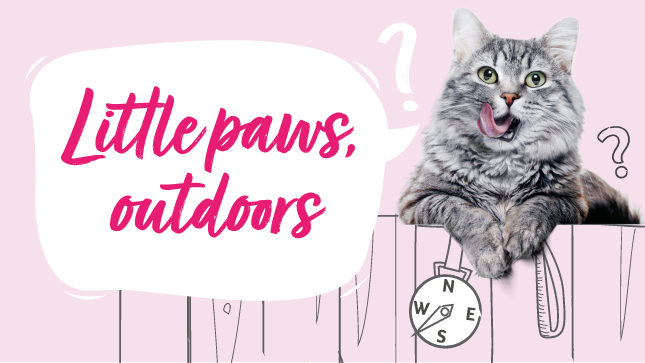
Letting your cat outside for the first time
Letting your cat out for the first time can be a daunting experience, especially when they seem so small and the world so wide. You may be wondering how to help your feline friend adjust to the outside world and make their way home again too.
Here’s all you need to know before letting your cat outside for the first time.
How long should I wait before letting my cat out?
The time you wait before letting your cat out will vary depending on their age as they get used to the new sights and smells around them but the most important thing to do is make sure that your new feline friend feels safe in their new surroundings first so that they’ll want to return home once they’ve been let outside.
When can kittens go outside?
If you have a kitten, it’s advised that you wait until they’re at least five months old before they go outside on their own. At this age, a cat should be mature enough to interact with other cats they might meet on their adventures.
You should also make sure that your kitten is confident enough in the house before letting them out.
Older cats
If your cat is a little older, you won’t need to wait as long. While every cat is different, you should generally wait at least 2-3 weeks and up to 4-6 weeks before letting your cat head outside for their first adventure in their new neighbourhood. This will give them plenty of time to settle in their new environment.
What does my cat need before heading out?
There are a few things that can help keep your cat safe in the big wide world. Before you let them out and about, you’ll need to get them:
- Microchipped.
- Vaccinated.
- Neutered.
Even if your cat is microchipped, it’s also a good idea for your cat to wear a quick-release collar that snaps open if it gets caught on something, with an ID tag containing your details. That way, you can be readily contacted by anyone if your cat becomes injured or goes missing.
The first time you let your cat out
Here are some steps you can take to help make your cat’s first taste of the outside world a little less daunting.
Before you get started: Make sure you choose a quiet day when there are no loud noises. So, avoid starting on your street’s bin collection day, for instance. You’ll want to start when it’s dry, too, so your cat gets a positive first experience.
It’s also worth making note of any potential hazards your cat may encounter when outside, such as busy traffic, other pets in the area and plants toxic to cats.
Step one: Before giving your cat breakfast, open the door to let them venture outside in their own time. Food is a fantastic method of limiting your cat’s outdoor time.
Step two: When (or if) your cat does go outside, let them explore at their own pace for around 10 minutes. Don’t be tempted to force them through the door or try picking them up as this can frighten them.
Step three: Call them back to you and put down their breakfast. This way, your cat learns that in order to eat, they must come home.
Step four: Repeat this every morning, gradually increasing their time outdoors until they start venturing a little further away from home.
How to train a cat to use a cat flap
Installing a cat flap will allow your cat to come and go as they please rather than always having to ‘ask’ to be let in or out and can help them feel happier at home. It can also make life easier for you, as you won’t always have to give in to their demands.
Cats naturally want to explore outside, so you might be surprised at how quickly they can work out the best way to do this.
Step one: Start by holding or wedging the cat flap open so that they can see the other side.
Step two: Encourage your cat to the cat flap by holding a treat or wiggling their favourite toy in front of it. Once you’ve done this a few times, you can then place a few treats or the toy you’ve chosen on the bottom edge of the cat flap itself.
Step three: Once your cat is comfortable approaching the cat flap, you can begin encouraging them to find their way through with a treat or the toy. Make sure you reward them for the smallest things from poking their head through or putting a paw over to the other side as this will allow them to have a positive association with the cat flap.
Step four: When your cat goes through the cat flap for the first time, be sure to give them an extra special treat and lots of praise! Practice this from both sides of the cat flap.
Step five: As soon as your cat has got to grips with going through an open cat flap, you’ll need to reverse the process by sitting inside the house and gently calling them to come back inside while teaching them how to push it themselves once it’s closed.
Be patient: Some cats will pick this up a lot quicker than others while some will need time to learn that it’s safe and benefits them in the long run.
Looking for more cat advice?
We’ve written some handy cat advice guides, to help you unlock the secrets of your mysterious moggy.
Need cat insurance?
Cat insurance can help cover the cost of veterinary treatment if your cat gets injured or falls ill.
